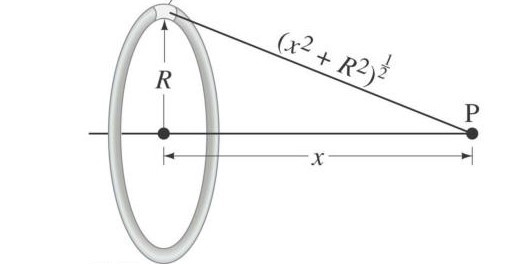
The surface charge density of a thin charged disc of radius R is σ. The value of the electric field at the center of the disc is
A. Reduces by 70.7%
B. Reduces by 29.3%
C. Reduces by 9.7%
D. Reduces by 14.6%
Answer
504.3k+ views
Hint: This can be solved by using the electric field due to a uniformly charged disc formula. We shall substitute the given values of radius and electric field at the center of the disc to find the electric field along the axis.
Complete step-by-step answer:

The general expression for an electric field due to a uniformly charged disc of radius R and charge density σ can be written as
Where,
On substituting ‘k’ in the formula, we get
Here, the given electric field intensity at the center of the disc shall be ‘E’ i.e.,
Let electric field along the axis at a distance ‘x’ from the center of the disc be ‘E1’ and written as
As
On taking ‘R’ common, it gets cancelled
We also know,
On substituting ‘E’ in the equation, we get
The percentage of reduction in the value of electric field can be calculated as
The negative sign indicates the reduction.
Therefore, the correct answer for the given question is option (A).
Note: The electric field due to a uniformly charged disc is based on the applications of gauss’s law. The law states that the total flux of electric field over a closed surface is equal to
Complete step-by-step answer:

The general expression for an electric field due to a uniformly charged disc of radius R and charge density σ can be written as
Where,
On substituting ‘k’ in the formula, we get
Here, the given electric field intensity at the center of the disc shall be ‘E’ i.e.,
Let electric field along the axis at a distance ‘x’ from the center of the disc be ‘E1’ and written as
As
On taking ‘R’ common, it gets cancelled
We also know,
On substituting ‘E’ in the equation, we get
The percentage of reduction in the value of electric field can be calculated as
The negative sign indicates the reduction.
Therefore, the correct answer for the given question is option (A).
Note: The electric field due to a uniformly charged disc is based on the applications of gauss’s law. The law states that the total flux of electric field over a closed surface is equal to
Recently Updated Pages
Master Class 9 General Knowledge: Engaging Questions & Answers for Success

Master Class 9 English: Engaging Questions & Answers for Success

Master Class 9 Science: Engaging Questions & Answers for Success

Master Class 9 Social Science: Engaging Questions & Answers for Success

Master Class 9 Maths: Engaging Questions & Answers for Success

Class 9 Question and Answer - Your Ultimate Solutions Guide

Trending doubts
Give 10 examples of unisexual and bisexual flowers

Draw a labelled sketch of the human eye class 12 physics CBSE

Differentiate between homogeneous and heterogeneous class 12 chemistry CBSE

Differentiate between insitu conservation and exsitu class 12 biology CBSE

What are the major means of transport Explain each class 12 social science CBSE

a Tabulate the differences in the characteristics of class 12 chemistry CBSE




